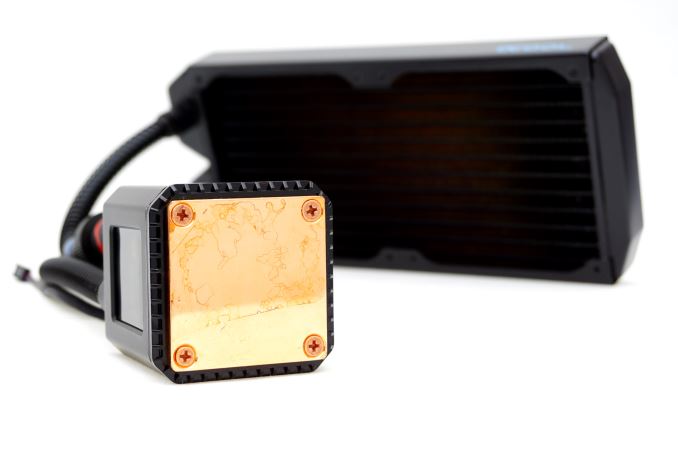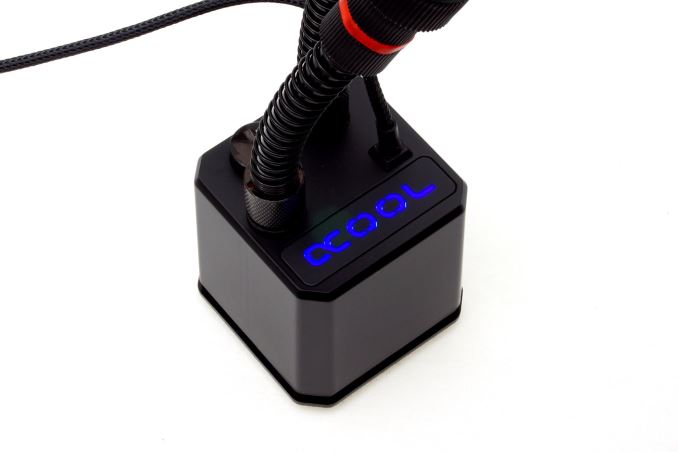The Alphacool Eisbaer 240 CPU AIO Liquid Cooler Review
by E. Fylladitakis on August 1, 2016 9:00 AM EST- Posted in
- Cases/Cooling/PSUs
- AIO
- Water Cooling
- Cooler
- Alphacool
Conclusion
In this review we had a look at Alphacool’s latest product and first AIO liquid cooler, the Eisbaer, which the company is marketing as an “extremely quiet, expandable solution”. It is true that the supplied 120 mm “Eiswind” fans did perform very well and that the ceramic pump is practically noiseless, making the Eisbaer 240 the least noisy AIO liquid cooler that we have tested to this date. Our only concern lies with the long term reliability of the fans, as while sleeve bearing engines are amongst the least noisy options, they lack the long-term reliability of other solutions that are noisier or expensive.
While the Eisbaer 240 did not outperform every other similar cooler in terms of raw thermal performance, it possibly has the best noise/performance ratio of every dual 120 mm fan AIO cooler available today. It could likely outperform several of its competitors if stronger fans were to be used, but we feel that Alphacool’s choice of fans in terms of noise performance hits the mark. Users can fall into two categories - thermal or acoustic performance, and a user that places acoustic comfort above a slim difference in thermal performance will do well here. Even with its quiet fans, the thermal performance of the Eisbaer is very good and more than adequate for the typical gamer/enthusiast that simply wants a cool and quiet high performance system.
The expandability of the Eisbaer 240 is one of the primary focus points of Alphacool’s marketing team. It is true that the Eisbaer 240 is very versatile, offering expansion options depending on the user’s skill and needs. It has a quick release connector on the tubing for users that want to keep things simple and expand using parts that the company supplies specifically for the Eisbaer, plus the company has simple tube compression fittings installed on every part that allow the user to completely remove the tubing if necessary. The Alphacool Eisbaer 240 practically is a standard, divisible liquid cooling kit that is being supplied preassembled and prefilled by the company.
Expanding the Eisbaer may be a relatively simple process but the user has to take into account the impact that the expansion will have on the performance of the system. For example, the insertion of a GPU block will add both resistance and thermal energy into the system, respectively reducing the flow of the pump and increasing the load of the radiator. A second radiator will offer quicker thermal energy dissipation but significantly burdens the pump. In theory, a single loop can be expanded to cover multiple GPU blocks and more than one radiator but, as the pump cannot be upgraded, we advise against the installation of more than three items per system. It is technically possible to add an external pump into the system but that would beat the purpose of having an AIO solution in the first place, as a customized kit would perform better and cost less at this point. Alphacool has informed us that they are currently designing a similar AIO liquid cooler for GPUs, the GPX-Pro. When the GPX-Pro becomes available, the interconnection between the two system will be possible, allowing them to share their radiators and double the pressure (but not the flow) of the pumps. Whether having the two systems interconnected will perform better than keeping them separated is a complicated discussion that depends on many specific details, such as the CPU/GPU, the position of the radiators, the strength of each pump, the usage of the system, etc., preventing us from being able to provide a simple and definite answer.
Alphacool currently retails the Eisbaer 240 in Europe for €115 incl. VAT plus shipping costs. Slightly lower pricing may be found via some of their local resellers. In the US, the Eisbaer 240 is available for $120 plus shipping. The price is higher than that of most similar competitive products, but reasonably so for a product that offers an expandable setup with a copper radiator and high thermal performance combined with near-silent operation. We highly recommend it to those seeking a low noise AIO cooling solution, especially when there is a significant preference for potential future expansions/upgrades.












69 Comments
View All Comments
Death666Angel - Tuesday, August 2, 2016 - link
Totally. liquid cooling in the end functions the same way as air cooling, since the water has to be cooled down by air cooling. It only functions as a quick way to get rid of the heat at the source, but then you need radiators (like traditional heatsinks have directly on the CPU/GPU) to get rid of the heat from the water. But since custom liquid cooling is not restricted to the space around the CPU socket or on the graphics card, you can have much more cooling area. I myself have a 2x2x120mm radiator and another 200x200mm radiator, that is probably a bit more area than a high end air cooling CPU and GPU HSF have combined. But I also have that installed in a mATX case. People who go higher end have several 280, 360 radiators installed in their cases or they go 9x120 or 9x140 with external radiators. That is much more cooling area than traditional socket and graphics card coolers can provide.retrospooty - Tuesday, August 2, 2016 - link
You can... But you need to find a quiet water pump. It may also be quiet day one and get louder over time. The other thing is the water pump and the power control behind it introduce 2 additional potential fail points... It just doesn't make a whole lot of sense if building a new system today. Skylake CPU's are very cool and fan noise on them can be zero or near zero even if you are overlocking the crap out of it.Death666Angel - Tuesday, August 2, 2016 - link
"custom loop cool" "Skylake CPU"No one in their right mind uses a custom liquid cooling solution just for the CPU. And since modern rigs can still easily produce 400 to 500W of excess heat if overclocked to their maximum (and that is just for the entry level enthusiast gear), water cooling still makes sense in those cases.
Also, pumps have been nearly silent for years and tests have shown that high water flow isn't really necessary for good cooling temperatures. So something like a throttled Phobya DC12-220 will provide enough power to give you 80l/h at throttled speeds with a CPU+GPU+2 radiators setup and run silently if you decouple it from the case and dampen it with rubber.
How does a WC setup get louder over time and air cooling does not? Mine does get slightly worse performance after a few months of not cleaning the radiator fans. But the same is true of air cooling. That's what a vacuum and compressed air is for. If you are talking about having gunk in your coolers, that shouldn't happen if you set it up right.
I've had a custom WC setup for nearly 6 years now, I've changed the graphics cards one and the cpu/MoBo once and cleaned everything when I did that. First time I had some gunk in the coolers which reduced the flow rate (I didn't use the right ratio for the water additives). Second time I had some gunk but no reduction in flow rate. Now I've not touched it for over a year and the flow rate is steady.
retrospooty - Tuesday, August 2, 2016 - link
I would agree, but it is said in relation to the article above on the Eisbaer 240 "CPU" AIO Liquid Cooler.Death666Angel - Tuesday, August 2, 2016 - link
"Can you make a custom loop cool better AND be quieter than a high end air tower?"Just because it is posted below this review, does not mean you should ignore what he actually asked.
retrospooty - Tuesday, August 2, 2016 - link
I am not sure what you are getting at... I answered his question. He said nothing about a video card, you said that after my post.HomeworldFound - Tuesday, August 2, 2016 - link
An Aquacomputer D5 paired with an Aquaero 6 and an Aqualis reservoir is silent. On my 5930k I can turn the pump down to 25% and my fans down to 500rpm and you can't hear a thing, it's quieter than my fridge freezer near the PC which is further away. I do have 2x 480mm 60mm radiators though.HomeworldFound - Tuesday, August 2, 2016 - link
and 980 SLI. Building a new rig now.ikjadoon - Tuesday, August 2, 2016 - link
Dude, you can buy an AIO CLC that does that, LOL.http://www.hardocp.com/article/2016/02/11/arctic_c...
zodiacfml - Tuesday, August 9, 2016 - link
I used to follow every and latest cooling tech throughout the years. For desktop cooling, it is as simple as having more surface area, radiator or heatsink. You can also effectively have a larger surface area there's a faster flow of air using faster, louder fans. For your question, having a large radiator beats a smaller air solution.These days though, it doesn't mean much anymore as Intel CPUs are focused on lower TDP's.
AIO coolers should focus their money and energy now on GPUs as it still has huge cooling requirements.